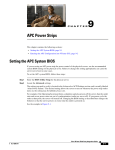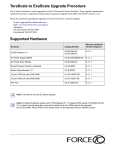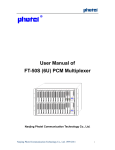Download Dell Force10 S50-01-GE-48T-V User's Manual
Transcript
S-Series Secure Management This application note describes how to enable the SSH and SSL secure management features on the S-Series platforms. Version 1.5 June 1, 2006 © 2004 Force10 Networks, Inc. All rights reserved. Force10, the Force10 logo, EtherScale, and FTOS are trademarks of Force10 Networks, Inc. All other brand and product names are trademarks or registered trademarks of their respective holders. Information in this document is subject to change without notice. Certain features may not yet be generally available. Force10 Networks, Inc. assumes no responsibility for any errors that may appear in this document. 1 S-Series Secure Management Table of Contents Introduction ...................................................................................................................................... 2 Enabling SSH................................................................................................................................... 2 Enabling SSL/HTTPS ...................................................................................................................... 4 Introduction Enabling secure management via Secure SHell (SSH) or Secure Sockets Layer (SSL/HTTPS) on the S-Series is a four-step process. SSH and SSL both provide an encrypted transport session between the management station and switch. 1. 2. 3. 4. Generate the SSH keys or SSL certificates offline. Copy the SSH keys or SSL certificates to the switch using TFTP. Enable the secure management server (SSH or HTTPS) on the switch. Disable the insecure version of the management server (Telnet or HTTP). If you received this document as part of a .zip file, the file should contain two directories: ssh and ssl (the directories are also on the S-Series CD-ROM). If you did not get the entire .zip file, please contact your Force10 account team. • • The ssh directory has example RSA1, RSA2 and DSA keys and a shell script called “generate-keys.sh” that can be used to generate your own SSH keys. The ssl directory has example certificates and a shell script called “generate-pem.sh” that can be used to generate your own SSL certificates. The scripts provided use OpenSSH (http://www.openssh.org/) and OpenSSL (http://www.openssl.org/) for key and certificate generation. Other free and commercial tools exist that can provide the same functionality and you can use them if you like. For additional options and commands related to the Telnet, SSH and HTTP/HTTPS features, please consult the SFTOS manuals. Enabling SSH 1. Generate the SSH keys using the script in the ssh directory, or copy the example keys (which end in .key) to your TFTP server. 2. Copy the keys to NVRAM with TFTP as follows from this example, using the IP address of your TFTP server. For SSHv1, copy the RSA1 key. For SSHv2, copy the RSA1, RSA2, and DSA keys, as shown below. SFTOS #copy tftp://192.168.0.10/rsa1.key nvram:sshkey-rsa1 Mode........................................... Set TFTP Server IP............................. TFTP Path...................................... TFTP Filename.................................. Data Type...................................... TFTP 192.168.0.10 rsa1.key SSH RSA1 key Management access will be blocked for the duration of the transfer Are you sure you want to start? (y/n) y TFTP SSH key receive complete... updating key file... Key file transfer operation completed successfully -2- S-Series Secure Management SFTOS #copy tftp://192.168.0.10/rsa2.key nvram:sshkey-rsa2 Mode........................................... Set TFTP Server IP............................. TFTP Path...................................... TFTP Filename.................................. Data Type...................................... TFTP 192.168.0.10 rsa2.key SSH RSA2 key Management access will be blocked for the duration of the transfer Are you sure you want to start? (y/n) y TFTP SSH key receive complete... updating key file... Key file transfer operation completed successfully SFTOS #copy tftp://192.168.0.10/dsa.key nvram:sshkey-dsa Mode........................................... Set TFTP Server IP............................. TFTP Path...................................... TFTP Filename.................................. Data Type...................................... TFTP 192.168.0.10 dsa.key SSH DSA key Management access will be blocked for the duration of the transfer Are you sure you want to start? (y/n) y TFTP SSH key receive complete... updating key file... Key file transfer operation completed successfully 3. Enable the SSH server with this command. SFTOS Version <= 2.2.1 (SFTOS) #ip ssh server enable SFTOS Version >= 2.3.1 SFTOS (Config)#ip ssh server enable To verify that the server has started, use this command to show the SSH server status and check the log file for the following messages. SFTOS #show ip ssh SSH Configuration Administrative Mode: .......................... Protocol Levels: .............................. SSH Sessions Currently Active: ................ Max SSH Sessions Allowed: ..................... SSH Timeout: .................................. Enabled Versions 1 and 2 0 5 5 SFTOS #show logging buffered JAN 01 00:31:54 192.168.0.34-1 started JAN 01 00:31:54 192.168.0.34-1 opened file ssh_host_dsa_key JAN 01 00:31:54 192.168.0.34-1 loaded DSA key JAN 01 00:31:54 192.168.0.34-1 opened file ssh_host_rsa_key JAN 01 00:31:54 192.168.0.34-1 loaded RSA2 key JAN 01 00:31:56 192.168.0.34-1 server key UNKN[222273672]: sshd_control.c(444) 15 %% SSHD: sshdListenTask UNKN[209305936]: sshd_main.c(596) 16 %% SSHD: successfully UNKN[209305936]: sshd_main.c(609) 17 %% SSHD: successfully UNKN[209305936]: sshd_main.c(631) 18 %% SSHD: successfully UNKN[209305936]: sshd_main.c(643) 19 %% SSHD: successfully UNKN[209305936]: sshd_main.c(353) 20 %% SSHD: Done generating -3- S-Series Secure Management Using an SSH client, connect to the switch and login to verify that the SSH server is working. 4. Once you have verified that you can connect to the switch with an SSH client, the Telnet server can be disabled with this command for additional security, if it was enabled. The Telnet server is disabled by default. SFTOS Version <= 2.2.1 (SFTOS) #no ip telnet server enable SFTOS Version >= 2.3.1 SFTOS (Config)#no ip telnet server enable Enabling SSL/HTTPS 1. Generate the SSL certificates using the script in the ssl directory, or copy the example certificates (which end in .pem) to your TFTP server. 2. Copy the certificates to NVRAM with TFTP as follows from this example, using the IP address of your TFTP server. SFTOS #copy tftp://192.168.0.10/dh512.pem nvram:sslpem-dhweak Mode........................................... Set TFTP Server IP............................. TFTP Path...................................... TFTP Filename.................................. Data Type...................................... TFTP 192.168.0.10 dh512.pem SSL DH weak Management access will be blocked for the duration of the transfer Are you sure you want to start? (y/n) y TFTP SSL certificate receive complete... updating certificate file... Certificate file transfer operation completed successfully SFTOS #copy tftp://192.168.0.10/dh1024.pem nvram:sslpem-dhstrong Mode........................................... Set TFTP Server IP............................. TFTP Path...................................... TFTP Filename.................................. Data Type...................................... TFTP 192.168.0.10 dh1024.pem SSL DH strong Management access will be blocked for the duration of the transfer Are you sure you want to start? (y/n) y TFTP SSL certificate receive complete... updating certificate file... Certificate file transfer operation completed successfully SFTOS #copy tftp://192.168.0.10/server.pem nvram:sslpem-server Mode........................................... Set TFTP Server IP............................. TFTP Path...................................... TFTP Filename.................................. Data Type...................................... TFTP 192.168.0.10 server.pem SSL Server cert Management access will be blocked for the duration of the transfer Are you sure you want to start? (y/n) y TFTP SSL certificate receive complete... updating certificate file... -4- S-Series Secure Management Certificate file transfer operation completed successfully SFTOS #copy tftp://192.168.0.10/rootcert.pem nvram:sslpem-root Mode........................................... Set TFTP Server IP............................. TFTP Path...................................... TFTP Filename.................................. Data Type...................................... TFTP 192.168.0.10 rootcert.pem SSL Root cert Management access will be blocked for the duration of the transfer Are you sure you want to start? (y/n) y TFTP SSL certificate receive complete... updating certificate file... Certificate file transfer operation completed successfully 3. Enable the HTTPS server with this command. SFTOS Version <= 2.2.1 (SFTOS) #ip http secure-server SFTOS Version >= 2.3.1 SFTOS (Config)#ip http secure-server enable To verify that the server has started, use this command to show the HTTPS server status and check the log file for the following messages. SFTOS #show ip http Java Mode: Disabled HTTP Mode (Unsecure): Disabled HTTP Mode (Secure): Enabled Secure Port: 443 Secure Protocol Level(s): TLS1 SSL3 SFTOS #show logging buffered JAN 01 01:16:19 192.168.0.34-1 UNKN[209189968]: sslt_util.c(321) 39 %% SSLT: Successfully loaded all required SSL PEM files Using a web browser, connect to the switch using an https:// URL and login to verify that the SSL server is working. The padlock icon on your browser should indicate an encrypted connection. If you used the example certificates, your browser will display a warning that it cannot verify the authenticity of the certificate. This is because the example certificates have not been certified by a Certification Authority. When certificates are acquired from a Certification Authority and loaded on the switch this warning will not occur. 4. Once you have verified that you can connect to the switch with a web browser, the HTTP server can be disabled with this command for additional security if it was enabled previously. The HTTP server is disabled by default. SFTOS Version <= 2.2.1 (SFTOS) #no ip http server SFTOS Version >= 2.3.1 SFTOS (Config)#no ip http server enable -5- S-Series Secure Management Force10 Networks, Inc. 1440 McCarthy Boulevard Milpitas, CA 95035 www.force10networks.com Phone: 408-571-3500 Fax: 408-571-3550 Email: [email protected] -6-






















